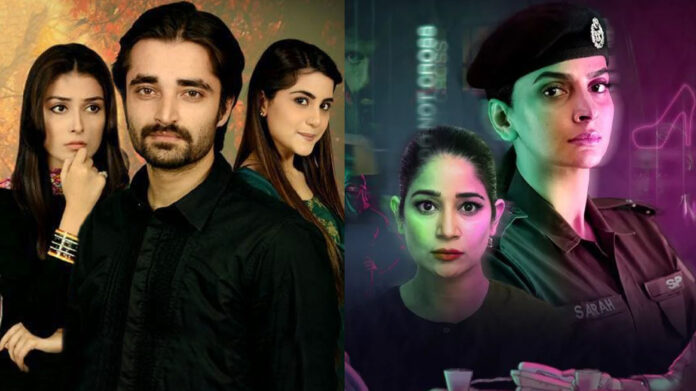How many times have we invested our hearts and souls into a drama, only to be left disappointed as the final curtain falls? It’s a more common occurrence than we might realize. Even the global phenomenon ‘Game of Thrones’ fell victim to this common tragedy witnessed ever so frequently in the entertainment universe.
Over the years, there have been numerous Pakistani dramas that captured our hearts but stumbled at the finish line with lacklustre endings. To address the collective outcry of the audience, we’ve compiled a list of five such dramas and imagined our desired endings for each.
Dastaan
The heart-wrenching series, ‘Dastaan’ has solidified itself as a timeless classic. Directed by Haissam Hussain and penned by Samira Fazal, it is a period drama adapted from a novel by Raiza Butt. Set in the pre-partition era, the drama captivates viewers by delving into the events surrounding partition and the harrowing violence that ensued.
Through the lens of Bano, portrayed remarkably by Sanam Baloch, we are exposed to the profound trauma experienced by those caught in the midst of partition. We witness the devastation as Bano loses her family, and the love of her life, and endures abuse and torture, all while maintaining an unwavering love for her new country, Pakistan. However, her idealized vision of Pakistan shatters upon her arrival, confronting her with a stark reality far from her expectations.
Haissam Hussain masterfully crafts the narrative, immersing viewers in Bano’s pain with every scene. Even over a decade since its release in 2010, our hearts still ache witnessing Bano’s tragic journey, especially as her love story with Hassan (portrayed by Fawad Khan) remains unfulfilled, culminating in her confinement to a mental asylum.
While the drama subtly imparts the message of recognizing the sacrifices of ancestors for Pakistan’s creation, the impact diminishes as the series progresses. Many hoped for Bano to find her happy ending. Perhaps, a resolution where Bano and Hassan reunite, allowing Bano to rediscover herself in the new Pakistan and eventually overcome her trauma with Hassan’s support, would have provided some relief. Even if depicted with realism, the drama could have portrayed Bano never reconnecting with her old true self, but in the end, both Bano and the audience had a ray of hope.
Kaise Teri Khudgarzi
‘Kaisi Teri Khudgarzi’ made waves upon its release, drawing in high ratings and millions of views per episode. The Danish Taimoor and Dur-e-Fishan duo stole the spotlight with their compelling performances, complemented by the lavish production and undeniable chemistry between the leads.
Penned by Radain Shah and helmed by Ahmed Bhatti, the drama delves into the life of Mehak Shamsher (portrayed by Dur-e-Fishan), a girl from a middle-class family whose world is turned upside down when she captures the attention of the influential Shamsher Dilawar (Danish Taimoor), who falls for her at first sight.
The crux of the storyline revolves around Shahmeer, portrayed as the epitome of toxic masculinity. While depicting such characters isn’t inherently problematic, the issue lies in the execution. The drama fails to adequately address the repercussions of toxic behaviour, inadvertently normalizing it.
The climax sees Mehak completely enamoured by Shahmeer, even following his death. The concluding scene shows them having a child together. However, this resolution falls short as it perpetuates the dangerous notion that forceful and non-consensual acts are acceptable and can win over affection.
Many viewers hoped for a different conclusion, one where Mehak chooses to break free from Shahmeer’s toxic influence, despite her lingering feelings for him. Such a narrative arc could have portrayed Mehak’s growth and realization that their relationship was founded on unhealthy dynamics. If it’s not too much to ask from our dramas, we would have appreciated Mehak seeking therapy for her trauma, which could have provided a more empowering resolution.
Pyarey Afzal
After a decade since the release of ‘Pyarey Afzal’ fans are still mesmerized by the timeless chemistry between the lead stars Hamza Ali Abbasi and Ayeza Khan, who are currently seen together in the drama ‘Jaan-e-Jahan’. However, the lingering nostalgia for the unrequited love story of the central characters Afzal and Farah, portrayed by Hamza Ali Abbasi and Ayeza Khan, stays with the audience.
Penned by Khalil-ur-Rehman Qamar and masterfully directed by Nadeem Baig, “Pyarey Afzal” narrates the poignant tale of two individuals whose love transcends societal norms and class barriers. As the drama approaches its climax, Khalil-ur-Rehman once again delivers a heart-wrenching ending, with Afzal tragically shot while on the phone with Farah, who confesses her love.
However, amidst the bittersweet conclusion, fans yearn for an alternate universe where Farah and Afzal unite against all odds, offering viewers a glimmer of hope and a blissful conclusion to their tumultuous journey. In this imagined scenario, the drama would culminate with scenes of Farah and Afzal revelling in their newfound happiness, symbolizing the triumph of love over adversity.
Ishq Zahe Naseeb
Crafted by Hashim Nadeem and brought to life under the direction of Farooq Rind, ‘Ishq Zahe Naseeb’ emerged as a truly distinctive addition to our drama landscape. With its bold exploration of personality disorder and mental health, intertwined with elements of thriller and suspense, the drama captivated audiences with its unconventional narrative approach.
Zahid Ahmed delivered a stellar performance in his portrayal of Sameer, a character grappling with dissociative identity disorder, with Sameera representing his female alter ego. Amidst the complexities of his condition, Sameer finds solace and love in Gauhar Rasheed, portrayed by Sonya Hussain, who steadfastly stands by his side through thick and thin.
While the drama held us spellbound with its intricate plot, the final episode fell short of expectations in terms of providing a satisfying conclusion. Despite prolonging the storyline in an attempt to capitalize on ratings, the drama ultimately wrapped up with a seemingly rushed and overly simplistic resolution, focusing solely on Gauhar and Sameer’s happily-ever-after as Sameer miraculously recovers.
Regrettably, this rushed conclusion left many narrative threads unresolved, leaving viewers with lingering questions and unexplored mysteries. Given the drama’s aim to shed light on mental health issues, it was essential to depict Sameer’s recovery journey in a more nuanced and comprehensive manner, delving deeper into the complexities of his condition and offering a more holistic portrayal of his healing process.
Serial Killer
The recent drama ‘Serial Killer’ penned by Umera Ahmed and directed by Fahad Noor, concluded its suspenseful journey with mixed reactions from viewers. Starring Saba Qamar as Sarah Sikander, the plot revolves around a gripping mystery surrounding a corpse found in a suitcase, thrusting Sarah into the depths of investigation and personal revelation upon her return from America.
However, as the curtains fell on the series and the killer was unveiled, the final episode failed to maintain the suspense and excitement that characterized the rest of the drama. The revelation of Barbara as the culprit felt predictable and lacked the shocking twist that viewers anticipated from a crime thriller. The absence of action and a slow-paced narrative left the audience longing for a more captivating conclusion.
A more satisfying ending could have involved a twist where someone unexpected, other than Barbara, was revealed as the killer. Alternatively, if Barbara remained the culprit, the narrative could have taken a more intriguing turn by introducing a subplot involving Zarish’s reappearance, suggesting a deeper conspiracy involving her and Batool in orchestrating the murders. Such developments would have added layers to the storyline and elevated the drama’s appeal as a crime thriller.




